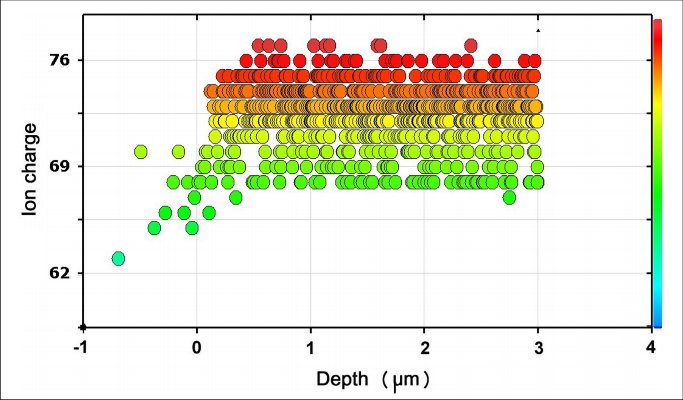| View previous topic :: View next topic |
| Author |
Message |
DanRRight
Joined: 10 Mar 2008
Posts: 2934
Location: South Pole, Antarctica
|
 Posted: Sun Jul 26, 2020 1:49 am Post subject: Native PL plot in the world top journal Posted: Sun Jul 26, 2020 1:49 am Post subject: Native PL plot in the world top journal |
 |
|
Journal "Nature" just published another paper where one of figures was made with FTN95 Clearwin native PL. This article reported how using advanced nanostructures to strip heavy atoms of most of their electrons utilizing relativistic laser pulses.
 |
|
| Back to top |
|
 |
Kenneth_Smith
Joined: 18 May 2012
Posts: 836
Location: Lanarkshire, Scotland.
|
 Posted: Sun Jul 26, 2020 10:07 am Post subject: Posted: Sun Jul 26, 2020 10:07 am Post subject: |
 |
|
Dan,
How do you get the x axis label of the %pl to include the greek letter mu i.e. your show micro metres with the correct SI symbol ? |
|
| Back to top |
|
 |
PaulLaidler
Site Admin
Joined: 21 Feb 2005
Posts: 8254
Location: Salford, UK
|
 Posted: Sun Jul 26, 2020 2:07 pm Post subject: Posted: Sun Jul 26, 2020 2:07 pm Post subject: |
 |
|
| One way is to call enable_utf8@(1). You can get the character by opening the Character Map dialog directly or from Plato. You don't need to set the font. The file must be saved using Advanced Save Options with "UNICODE (UTF-8 without signature)". |
|
| Back to top |
|
 |
Kenneth_Smith
Joined: 18 May 2012
Posts: 836
Location: Lanarkshire, Scotland.
|
 Posted: Sun Jul 26, 2020 5:22 pm Post subject: Posted: Sun Jul 26, 2020 5:22 pm Post subject: |
 |
|
Thanks Paul, that works fine.
John, Example below:
| Code: |
module sine_mod
use clrwin
implicit none
integer, parameter :: dp = kind(1.d0)
integer, parameter :: n=360+1
real(kind=dp), parameter :: pi = 4.d0*atan(1.d0), deg2rad = pi/180.d0, sqrt2 = sqrt(2.d0)
real(kind=dp) x1(1:n), y1(1:n)
contains
integer function build_gui()
integer winio@, i
integer, save :: iw
x1 = (/(deg2rad*(i-1),i=1,n,1)/) ; y1 = sqrt2*sin(x1)
call enable_utf8@(1)
iw = winio@('%mn[Exit]&','exit')
iw = winio@('%fn[consolas]&')
call winop@('%pl[native, independent, x_array, n_graphs=1,gridlines,frame,y_min=-1.5,y_max=1.5, dy=0.5]')
call winop@('%pl[title="2π (rad) = 360�",x_axis=" Angle θ (rad)",y_axis=@]')
iw= winio@('%bf%ts&',2.d0)
iw = winio@('%pl&',600,400,n,x1,y1)
iw = winio@(' ')
build_gui =1
end function build_gui
end module sine_mod
program main
use sine_mod
implicit none
integer i
i = build_gui()
end program main |
|
|
| Back to top |
|
 |
Robert

Joined: 29 Nov 2006
Posts: 459
Location: Manchester
|
 Posted: Sun Jul 26, 2020 6:46 pm Post subject: Posted: Sun Jul 26, 2020 6:46 pm Post subject: |
 |
|
ALT + 0181
0181 have to be numeric pad digits |
|
| Back to top |
|
 |
PaulLaidler
Site Admin
Joined: 21 Feb 2005
Posts: 8254
Location: Salford, UK
|
 Posted: Sun Jul 26, 2020 7:27 pm Post subject: Posted: Sun Jul 26, 2020 7:27 pm Post subject: |
 |
|
John
One way is to follow my directions above.
1) From Plato, goto to the View menu and select Character Map.
2) Find the character that you want and copy it to the clipboard.
3) Paste the character into your code.
4) Find the Advanced Save Options on the File menu, open the dialog and select UNICODE etc. as descibed above. |
|
| Back to top |
|
 |
Robert

Joined: 29 Nov 2006
Posts: 459
Location: Manchester
|
 Posted: Mon Jul 27, 2020 4:45 pm Post subject: Posted: Mon Jul 27, 2020 4:45 pm Post subject: |
 |
|
| What is a 'relativistic laser pulse'? |
|
| Back to top |
|
 |
DanRRight
Joined: 10 Mar 2008
Posts: 2934
Location: South Pole, Antarctica
|
 Posted: Mon Jul 27, 2020 8:25 pm Post subject: Posted: Mon Jul 27, 2020 8:25 pm Post subject: |
 |
|
Robert,
It is when the laser field becomes so strong that it is capable to accelerate the electrons in one oscillation of the field close to their momentum M=mc and energy close to famous E=mc^2 = 511 keV (where m is electron rest mass and c is speed of light). At such intensities the relativistic effects start to dominate. In this work the laser was even 20x more powerful than that
Last edited by DanRRight on Sun Aug 02, 2020 1:12 am; edited 1 time in total |
|
| Back to top |
|
 |
|



